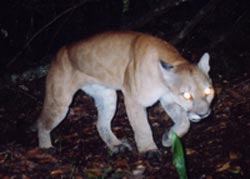
Wildlife professor updates ’best available science’ on Florida panther

When researchers and policymakers consider the best ways to protect an endangered species, the phrase “best available science” is frequently used to describe the scientific basis behind decisions that are aimed at preserving natural habitat and preventing further decline in species population.
However, the “best available science” has been shortchanging the Florida panther, according to an article by Liza Gross in the Pulbic Library of Science Biology (Aug. 23, 2005) and a report to be published in the January 2006 issue of the Journal of Wildlife Management (Beier P, Vaughan M, Conroy M, Quigley H. “Deconstructing flawed scientific inferences about the Florida panther.”).
Since 2002, fisheries and wildlife science professor Mike Vaughan has been one of four members of a Science Review Team put in place to review the research of the State of Florida and the U.S. Fish and Wildlife Service (FWS) on one of the country’s most endangered species: the Florida panther. As a team member and an expert on large carnivore ecology, Vaughan reviewed more than 20 years and 3,000 pages of scientific literature based on Florida panther research.
His analysis revealed serious flaws in their research and understanding of habitat requirements for the panthers. Vaughan pointed out that although the existing research conducted and adhered to by the FWS and State of Florida was loaded with what he called “improper inferences,” it still was “taken as gospel once it was published, and [therefore] this flawed research keeps being cited.”
The idea of reviewing research on the Florida panther was first brought to Vaughan’s attention by his former Ph.D. student John Kasbohm, who was the coordinator of the Florida panther recovery program for the U.S. FWS.
As Vaughan and his colleagues reviewed the data gathered in the panther research, they quickly identified a major source of oversight in the service’s analysis of panther habitat requirements. The researchers collected only daytime activity data on the Florida feline and failed to acknowledge the cat’s nocturnal nature.
Not realizing that a panther’s nighttime activity may cover greater area than during the day, the federal and state researchers made generalizations from the daytime data to cover an entire 24-hour period. This led to the unfounded conclusion that panthers wouldn’t travel more than 90 meters outside of a forested area. Furthermore, numerous decisions related to development and land use in Florida have resulted from the FWS’ erroneous assumptions that fail to acknowledge the panther’s true range of coverage.
The work of the Science Review Team and Vaughan recently led the U.S. Fish and Wildlife Service to revise its guidelines. The Florida panther population has been increasing from 40 to 50 cats in 1995 to approximately 80 today, and Vaughan suggests this positive trend can continue by “reanalyzing existing data and gathering more data on kitten survival so that population growth and reproductive rates can be modeled.”
Is it a panther, wildcat, cougar, puma, or mountain lion?
Within North America, the names “panther, wildcat, cougar, and mountain lion” are used interchangeably to describe a large, predatory feline. When asked what the difference is among these varieties, Mike Vaughan explains that they are genetically all the same. Vaughan bases this notion on the studies of a former wildlife science research associate Melanie Culver, who examined the genetic composition of each cat. Vaughan attributes the difference in terminology to regional distinctions and minor variations in physical features like skull size. In fact, Vaughan adds “relocation studies with the Texas cougar in Florida have shown the large carnivore can adapt, intermingle with the native panther, and thrive its new environment.”












